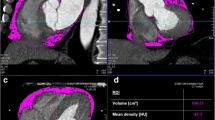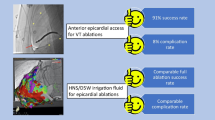Abstract
Purpose
We sought to better understand the association between and clinical implications of ganglionated plexi (GPs), epicardial adipose tissue (EAT) in the left atrium (LA), and the initiation and maintenance of atrial fibrillation (AF).
Methods
Three-dimensional (3D) computed tomography (CT) reconstruction images of the LA, PVs, and LA-EAT were merged with the LA geometry for 25 with paroxysmal AF (PAF) and 15 with persistent AF (PerAF) scheduled for ablation. High-frequency stimulation (20 Hz, 25 mA, 10 ms) was performed at three sites within each of the five major anatomical LA GPs (superior left, inferior left, anterior right, inferior right, and Marshall tract GPs) to elicit vagal responses. Correspondence between the five GP areas and vagal response sites, LA-EAT, and complex fractionated atrial electrograms (CFAEs) was examined. The long-term outcomes of adjuvant LA-EAT-based ablation were assessed in 31 patients with PAF and 102 with PerAF.
Results
LA-EAT overlapped 93 ± 14 % of five major anatomical GP areas, and the vagal response sites and CFAE sites corresponded to 77 ± 23 and 76 ± 25 %, respectively (p < 0.05 for both vs. LA-EAT locations). The EAT-based ablation eliminated 97.6 % of the vagal response sites and lengthened the AF cycle from 160 ± 26 to 193 ± 27 ms (p < 0.001). The 2-year arrhythmia-free rate after EAT-based ablation was 72 % in the PAF group and 73 % in the PerAF group (p = 0.614).
Conclusions
LA-EAT tends to overlie the major anatomical GP areas including most of the active GP response sites and CFAEs associated with AF. Ablation of GPs and CFAEs may explain the long-term efficacy of EAT-based ablation following extensive encircling pulmonary vein isolation (EEPVI) for AF.






Similar content being viewed by others
References
Wanahita, N., Messerli, F. H., Bangalore, S., Gami, A. S., Somers, V. K., & Steinberg, J. S. (2008). Atrial fibrillation and obesity—results of a meta-analysis. American Heart Journal, 155(2), 315–315.
Watanabe, H., Tanabe, N., Watanabe, T., Darbar, D., Roden, D. M., Sasaki, S., et al. (2008). Metabolic syndrome and risk of development of atrial fibrillation: the Niigata preventive medicine study. Circulation, 117(10), 1255–1260.
Liang, K. W., Tsai, I. C., Lee, W. J., Lee, I. T., Lee, W. L., Lin, S. Y., et al. (2012). MRI measured epicardial adipose tissue thickness at the right AV groove differentiates inflammatory status in obese men with metabolic syndrome. Obesity, 20(3), 525–532.
Yorgun, H., Canpolat, U., Hazırolan, T., Ateş, A. H., Sunman, H., Dural, M., et al. (2013). Increased epicardial fat tissue is a marker of metabolic syndrome in adult patients. International Journal of Cardiology, 165(2), 308–313.
Thanassoulis, G., Massaro, J. M., O’Donnell, C. J., Hoffmann, U., Levy, D., Ellinor, P. T., et al. (2010). Pericardial fat is associated with prevalent atrial fibrillation: the Framingham Heart Study. Circulation. Arrhythmia and Electrophysiology, 3(4), 345–350.
Nagashima, K., Okumura, Y., Watanabe, I., Nakai, T., Ohkubo, K., Kofune, T., et al. (2011). Association between epicardial adipose tissue volumes on 3-dimensional reconstructed CT images and recurrence of atrial fibrillation after catheter ablation. Circulation Journal, 75(11), 2559–2565.
Masuda, M., Mizuno, H., Enchi, Y., Minamiguchi, H., Konishi, S., Ohtani, T., et al. (2015). Abundant epicardial adipose tissue surrounding the left atrium predicts early rather than late recurrence of atrial fibrillation after catheter ablation. Journal of Interventional Cardiac Electrophysiology, 44(1), 31–37.
Nagashima, K., Okumura, Y., Watanabe, I., Nakai, T., Ohkubo, K., Kofune, M., et al. (2012). Does location of epicardial adipose tissue correspond to endocardial high dominant frequency or complex fractionated atrial electrogram sites during atrial fibrillation? Circulation. Arrhythmia and Electrophysiology, 5(49), 676–683.
Nakatani, Y., Kumagai, K., Minami, K., Nakano, M., Inoue, H., & Oshima, S. (2015). Location of epicardial adipose tissue affects the efficacy of a combined dominant frequency and complex fractionated atrial electrogram ablation of atrial fibrillation. Heart Rhythm, 12(2), 257–265.
Nakagawa, H., Scherlag, B. J., Patterson, E., Ikeda, A., Lockwood, D., & Jackman, W. M. (2009). Pathophysiologic basis of autonomic ganglionated plexus ablation in patients with atrial fibrillation. Heart Rhythm, 6(12 Suppl), S26–34.
Armour, J. A., Murphy, D. A., Yuan, B. X., Macdonald, S., & Hopkins, D. A. (1997). Gross and microscopic anatomy of the human intrinsic cardiac nervous system. The Anatomical Record, 247(2), 289–298.
Haïssaguerre, M., Hocini, M., Sanders, P., Sacher, F., Rotter, M., Takahashi, Y., et al. (2005). Catheter ablation of long-lasting persistent atrial fibrillation: clinical outcome and mechanisms of subsequent arrhythmias. Journal of Cardiovascular Electrophysiology, 16(11), 1138–1147.
Verma, A., Jiang, C. Y., Betts, T. R., Chen, J., Deisenhofer, I., Mantovan, R., et al. (2015). Approaches to catheter ablation for persistent atrial fibrillation. New England Journal of Medicine, 372(19), 1812–1822.
Nakahara, S., Hori, Y., Kobayashi, S., Sakai, Y., Taguchi, I., Takayanagi, K., et al. (2014). Epicardial adipose tissue-based defragmentation approach to persistent atrial fibrillation: its impact on complex fractionated electrograms and ablation outcome. Heart Rhythm, 11(8), 1343–1351.
Malcolme-Lawes, L. C., Lim, P. B., Wright, I., Kojodjojo, P., Koa-Wing, M., Jamil-Copley, S., et al. (2013). Characterization of the left atrial neural network and its impact on autonomic modification procedures. Circulation. Arrhythmia and Electrophysiology, 6(3), 632–640.
Katritsis, D. G., Pokushalov, E., Romanov, A., Giazitzoglou, E., Siontis, G. C., Po, S. S., et al. (2013). Autonomic denervation added to pulmonary vein isolation for paroxysmal atrial fibrillation: a randomized clinical trial. Journal of the American College of Cardiology, 62(24), 2318–2325.
Yu, Y., Wei, C., Liu, L., Lian, A. L., Qu, X. F., & Yu, G. (2014). Atrial fibrillation increases sympathetic and parasympathetic neurons in the intrinsic cardiac nervous system. Pacing and Clinical Electrophysiology, 37(11), 1462–1469.
Lin, J., Scherlag, B. J., Zhou, J., Lu, Z., Patterson, E., Jackman, W. M., et al. (2007). Autonomic mechanism to explain complex fractionated atrial electrograms. Journal of Cardiovascular Electrophysiology, 18(11), 1197–1205.
Katritsis, D., Giazitzoglou, E., Sougiannis, D., Voridis, E., & Po, S. S. (2009). Complex fractionated atrial electrograms at anatomic sites of ganglionated plexi in atrial fibrillation. Europace, 11(3), 308–315.
Hatem, S., & Sanders, P. (2014). Epicardial adipose tissue and atrial fibrillation. Cardiovascular Research, 102(2), 205–213.
Mazurek, T., Zhang, L., Zalewski, A., Mannion, J. D., Diehl, J. T., Arafat, H., et al. (2003). Human epicardial adipose tissue is a source of inflammatory mediators. Circulation, 108(20), 2460–2466.
Greulich, S., Maxhera, B., Vandenplas, G., de Wiza, D. H., Smiris, K., Mueller, H., et al. (2012). Secretory products from epicardial adipose tissue of patients with type 2 diabetes mellitus induce cardiomyocyte dysfunction. Circulation, 126(19), 2324–2334.
Venteclef, N., Guglielmi, V., Balse, E., Gaborit, B., Cotillard, A., Atassi, F., et al. (2013). Human epicardial adipose tissue induces fibrosis of the atrial myocardium through the secretion of adipo-fibrokines. European Heart Journal, 36(13), 795–805.
Sacks, H. S., Fain, J. N., Holman, B., Cheema, P., Chary, A., Parks, F., et al. (2009). Uncoupling protein-1 and related messenger ribonucleic acids in human epicardial and other adipose tissues: epicardial fat functioning as brown fat. Journal of Clinical Endocrinology and Metabolism, 94(9), 3611–3615.
Higuchi, K., Akkaya, M., Koopmann, M., Blauer, J. J., Burgon, N. S., Damal, K., et al. (2013). The effect of fat pad modification during ablation of atrial fibrillation: late gadolinium enhancement MRI analysis. Pacing and Clinical Electrophysiology, 36(4), 467–476.
Acknowledgments
The authors thank Ms. Wendy Alexander-Adams and Mr. George Powell for their encouragement and assistance with the reporting of our findings in English.
Author information
Authors and Affiliations
Corresponding author
Ethics declarations
Conflict of interest
The authors declare that they have no competing interests.
Funding sources
The study was supported by departmental resources only.
Rights and permissions
About this article
Cite this article
Takahashi, K., Okumura, Y., Watanabe, I. et al. Anatomical proximity between ganglionated plexi and epicardial adipose tissue in the left atrium: implication for 3D reconstructed epicardial adipose tissue-based ablation. J Interv Card Electrophysiol 47, 203–212 (2016). https://doi.org/10.1007/s10840-016-0130-9
Received:
Accepted:
Published:
Issue Date:
DOI: https://doi.org/10.1007/s10840-016-0130-9




